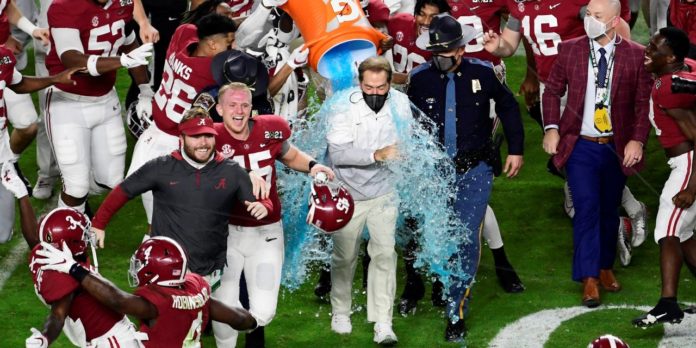
There’s an old saying: If you see a duck riding a bicycle, and I see a duck riding a bicycle, sometimes you still need the Supreme Court to unanimously say that it sees a duck riding a bicycle, too.
OK. Fine. “Duck on a Bike” may be the title of a children’s book by David Shannon, but the above is not an old saying. I made it up.
Still, that’s effectively what happened Monday, as the nation’s highest court confirmed what any reasonable person can see, that big-time intercollegiate athletics is a warped, hard-to-defend product.
We all knew this, of course. The big numbers are right in our faces. By now, everyone’s read about the billion-dollar network deals; the millionaire coaches sheltered by eight-figure buyouts; the assistants out-earning school presidents; the gilded facilities with world-class weight rooms and wellness lounges appointed like five-star resorts.
Schools weren’t embarrassed by this spending—they bragged about it. As they barred their own athletes from sharing the cash, they touted coaching hires flown in by private jet, and locker rooms with theater seats and flat screen TVs.
Big-time college athletics were so flush with cash, they couldn’t hide it.
Turns out, the NCAA couldn’t defend it, either.
Now the Supremes have jabbed an elbow at the whole facade. The 9-0 decision, written by Justice Neil Gorsuch, is narrow in scope—it’s an affirmation of lower court rulings that the NCAA’s restriction of educational benefits for athletes violated antitrust laws—but it doesn’t disguise its distaste for the mythology and market-fixing that have long sustained high-revenue college sports like football and men’s basketball.
“Those who run this enterprise profit in a different way than the student-athletes whose activities they oversee,” Justice Gorsuch wrote. “The president of the NCAA earns nearly $4 million per year. Commissioners of the top conferences take home between $2 [million] to $5 million. College athletic directors average more than $1 million annually. Annual salaries for top Division I college football coaches approach $11 million, with some of their assistants making more than $2.5 million.”
In other words, it’s a lucrative, almost completely market-driven business, with a killer edge—restricting compensation for the talent on the field.
“The bottom line is that the NCAA and its member colleges are suppressing the pay of student athletes who collectively generate billions of dollars in revenues for colleges every year,” Justice Brett Kavanaugh wrote in a concurring opinion, and yes, he really italicized “billions.” “Those enormous sums of money flow to seemingly everyone except the student athletes.”
Before this court, and in the past, the NCAA defended its position with flimsy claims of amateurism and how it gave the industry a singular appeal. It tried to instill a fear that removing guardrails on athlete compensation would turn college sports into just another pro sports free-for-all, demolishing smaller, nonrevenue sports in the process.
SCOTUS was unmoved. They did not buy the NCAA’s doomsdayism on the matter of educational benefits—it did not buy that perks like scholarships to graduate school, computers and tutoring would quickly be converted into Lamborghinis—and it sounds like Justice Kavanaugh didn’t buy any of it at all.
To the Justices, it all smacked of collusion and anti-competitive behavior.
“The NCAA’s business model would be flatly illegal in almost any other industry in America,” Justice Kavanaugh wrote. “All of the restaurants in a region cannot come together to cut cooks’ wages on the theory that ‘customers prefer’ to eat food from low-paid cooks. Law firms cannot conspire to cabin lawyers’ salaries in the name of providing legal services out of a ‘love of the law.’”
Again, none of this is breaking news. As Justice Gorsuch wrote: “From the start, American colleges and universities have had a complicated relationship with sports and money.” The opinion, very much worth reading, contains a useful primer on the entanglement, including an 1852 Harvard-Yale boat race sponsored by a railroad executive to early 20th century “tramp athletes” playing college football for cash and ESPN’s annual $470 million payment for college football playoffs and other games. (Here, SCOTUS gave a shout to the reporting of the Journal’s Rachel Bachman.)
If the warped economy of big-time college sports was always there, what changed? I asked Jeffrey Kessler, who argued on behalf of athletes in front of the Court.
“I think it’s a growing public awareness, it’s communication and information,” Kessler said. He cited the phenomenon of college football “strength coaches” making more money than university presidents.
“That didn’t exist 30 years ago,” Kessler said. “It’s become so extreme, so obvious, that now everyone can see that not only does the emperor have no clothes—but it’s time he covered up.”
To salvage its golden goose, the NCAA will cling to the decision’s limited reach, and tout its recent openness to allowing athletes to capitalize on their name, image and likeness. But this feels like an era’s end, hubris rebuked. There’s no political refuge here—as the Journal’s Louise Radnofsky wrote, if there’s one area that Democrat and Republicans agree upon, it’s irritation at the NCAA. The legal system is unlikely to be a harbor, either.
“This is a 9-0 decision by the Supreme Court making one thing very clear: the NCAA is subject to the same antitrust rules as every other business,” Kessler said. Justice Kavanaugh leaned into the NCAA nightmare of athletes using collective bargaining to negotiate “a fairer share of the revenues that they generate for their colleges, akin to how professional football and basketball players have negotiated for a share of league revenues.”
How about that? A duck rode by on a bicycle, and everyone saw it.
SHARE YOUR THOUGHTS
What do you think about the Supreme Court’s ruling?
Write to Jason Gay at Jason.Gay@wsj.com
Copyright ©2020 Dow Jones & Company, Inc. All Rights Reserved. 87990cbe856818d5eddac44c7b1cdeb8







